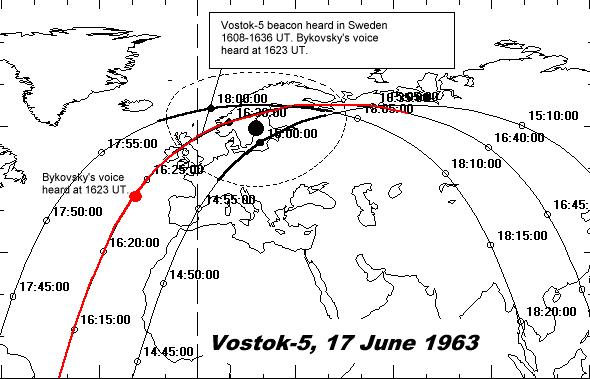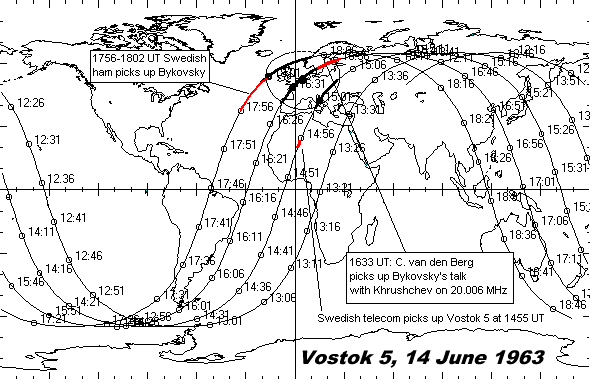
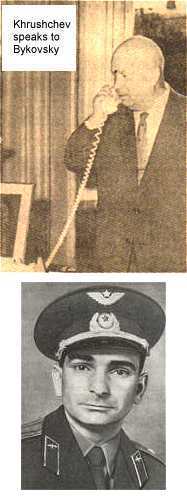 The
rumours about the launch of a female cosmonaut first appeared in the
press
in mid-April 1963 (8). The source of the
rumour was an article in Pravda written by cosmonauts Gagarin and Titov
and in which they said that "both sons and daughters of the Soviet
Union"
would be launched in to space.
The
rumours about the launch of a female cosmonaut first appeared in the
press
in mid-April 1963 (8). The source of the
rumour was an article in Pravda written by cosmonauts Gagarin and Titov
and in which they said that "both sons and daughters of the Soviet
Union"
would be launched in to space.
Just after the launch of Vostok-5 one of the tracking stations of 'manned space flight' (calling without identification) ordered VIKA 'to leave this frequency - 20 MHz - immediately for a cosmonaut was working on this frequency'. I did not expect the launch of a manned vehicle and for me this 'order' was the proof that somebody was in orbit!...." (3)
Vostok-5 was launched from Baikonur at 1158:58 UT on 14 June 1963 carrying cosmonaut Valeri Bykovsky.
"For me, brought up as a komsomolets , it is a great pleasure to execute such a honorable task of the Soviet Fatherland. It is a dream for me to become a communist of our great Leninist party. With my whole soul I thank the Soviet people for the good wishes and I will do all to successfully execute the flight program. Cosmonaut Bykovsky."
For a few minutes he speaks with Khrushchev (Nikita Sergeyevich) and with a friend (Pasha, or Vasha). (Statements like: Feeling well, very pleased, a lot of joy, understood, will show microgravity, etc.)
Chris also picked up the HF beacon on 19.948 MHz

In Sweden, the
Telecommunications
Administration picked up a brief message from Bykovsky at 1455 UT and
the
radio amateur Reimar Stridh reported hearing Bykovsky in Stockholm very
well at 1756-1802 UT (1).
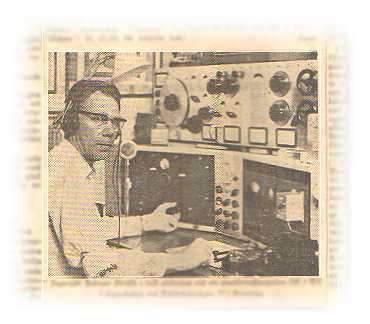 At
about 0700 UT it was clear to Swedish radio amateur Reimar Stridh (see
picture on the right) (2) that something
extraordinary
was about to happen at the Soviet launch site Baikonur. Rumours in the
press indicated that the launch of the first female space traveller was
imminent. The activity on the satellite frequency 20.006 MHz became
feverish
at about 0715 UT in connection with preparations for the launch of
Vostok-6.
Valeri Bykovsky had been heard by Mr. Stridh on several occasions, so
he
was well at home on the frequency in question.
At
about 0700 UT it was clear to Swedish radio amateur Reimar Stridh (see
picture on the right) (2) that something
extraordinary
was about to happen at the Soviet launch site Baikonur. Rumours in the
press indicated that the launch of the first female space traveller was
imminent. The activity on the satellite frequency 20.006 MHz became
feverish
at about 0715 UT in connection with preparations for the launch of
Vostok-6.
Valeri Bykovsky had been heard by Mr. Stridh on several occasions, so
he
was well at home on the frequency in question.
Vostok-6 with Valentina Tereshkova was launched from Baikonur at 0929:52 UT and Moscow promptly released the news to the world. At 1226 UT a female voice broke through the loudspeaker of Mr. Stridh's receiver: "Ya Chaika, ya Chaika (I am seagull)" she called with such signals strength that it appeared that the spacecraft was overhead. The Russian female space traveler communicated for a few minutes with one of the Soviet Ground stations. On the next orbit Valentina appeared again at about 1525 UT, slightly weaker, but well audible. After that she was in contact with Valeri Bykovsky (Yastreb) at about 1650 UT. Then she briefly talked to a Russian ground station at 1710 UT. (Listen to Valentina Tereshkova calling Vjezna 1).
At 1836 UT, Yastreb was heard again, this time in touch with the Russian ground station: "Vjezna 1, Vjezna 1, I hear you well and I have understood all you sent", the cosmonaut explained and asked if the ground station had understood the instrument readings. Valeri Bykovsky sounded somewhat irritated when the reply took some time: "What takes you so long". The conversation between Yastreb and Vjezna 1 ended when Valeri Bykovsky explained that he did not have time to talk more because he was preparing for his next television broadcast. Valentina Tereshkova in Vostok-6 was heard by Mr. Stridh once again at 2004 UT, when Bykovsky and the ground were also heard.
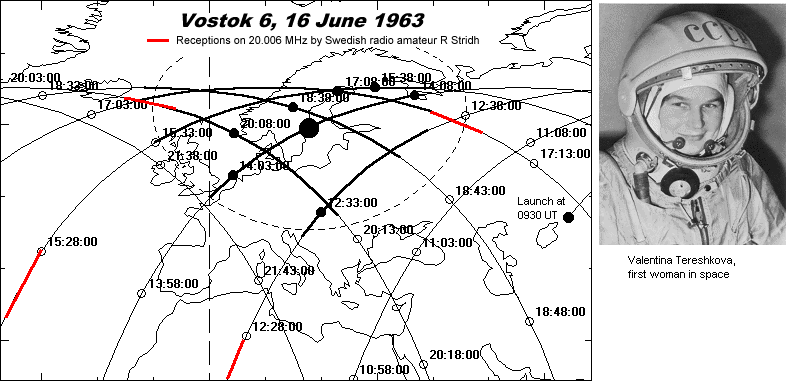
Monday 17 June 1963
Beacon from Vostok-6 on 19.995 MHz picked up my the Swedish Telecommunications Administration monitoring station in Enköping near Stockholm at 1611-1731 UT (Here is the radio beacon from Vostok 6. [Recording: Kettering Grammar School]). Beacon from Vostok-5 was heard at 1608-1636 and Bykovsky's voice at 1623 UT.
Earlier in the day the ground had had difficulty in raising Tereshkova and asked Bykovsky to help, but to no avail (4): At 1100 UT, when both ships were over the mid-Pacific area a Japanese station in Chiba east of Tokyo heard a Soviet ground station call "Yastreb, Yastreb,...contact cosmonaut Tereshkova. We cannot contact her from the ground". Bykovsky replied "I have tried myself to contact her without success, but I don't think there is reason to worry." By looking at the maps below we can see that the two spacecraft did not have line-of-sight contact during 17 June 1963.
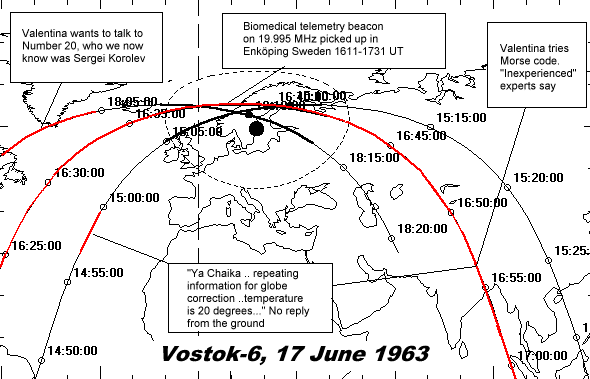
For several hours ground stations kept calling Valentina without success. Valentina also tried to contact the ground. It seemed there was something wrong with her receiver or she was tuned to the wrong reception channel. At the Swedish station in Enköping a message from her was picked up at 1458 UT in which she said: "Ya Chaika,..repeating information for globe corrections....[numbers]...I feel fine. All is well onboard. Temperature in the ship is 20 degrees. Do you read?", but there was no reply (7). The same procedure repeated itself at 1654 UT when the Enköping station again heard voice from Tereshkova (4). She even tried Morse code, which the experts judged as "inexperienced". Finally, after more confusion, the communications problems were gone and at 1800 UT Valentina could be heard talking to ground stations and ask to speak to "Number 20" - who we now know was the "Chief Designer" Sergei Korolev himself.
How serious were these
communication
difficulties with Tereshkova? To find out I asked Bart Hendrickx to
look
into the diary of Nikolai Kamanin, head of cosmonaut training. This is
what Bart Hendrickx wrote (9): " .....That
day
Kamanin was on duty at the Baikonur ground station beginning at 10 a.m.
(not clear whether that was Baikonur or Moscow time). He wrote : 'During
the 8 hours of my shift communications with both ships were excellent.
Bykovskiy reported : "Communication with 'Chaika' is excellent, she is
singing songs for me".' ..... " So, it seems that the problem was
never
big enough to surface even in Kamanin's detailed diary. Of course the
problems
could have occurred well before Kamanin started his shift, which, if
given
Baikonur time, was at 1500 UT.
